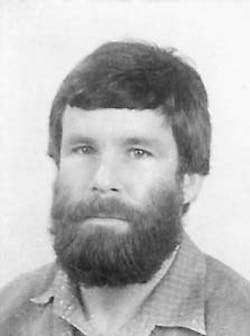SEYCHELLES BEACH TAPS, WELL OIL TIED TO SAME SOURCE ROCK
Phil Plummer
Seychelles National Oil Co.
Victoria, Mahe, Seychelles
Geochemical analyses of beach-stranded tars from Seychelles can be correlated to comparable analyses of an oil sample from a well in the Seychelles offshore.
The analyses also enable the precursor source rock to be characterized. Such a source rock was encountered in the three offshore wells (Fig. 1) (35250 bytes) and is extensively developed to the west and south of the granitic islands.
Enterprise Oil plc, London, plans to drill a well off Seychelles in second half 1995.
BACKGROUND
The first samples of beach-stranded tar in Seychelles were collected from Coetivy Island in 1978. They were subjected to analysis of n-C15+ saturates by gas chromatography (GC), which gave a bimodal alkane distribution with peaks at n-C26 and n-C35. However, no interpretation of precursor source rocks was attempted.
Sporadic collections of such tars have been made subsequently from Coetivy, as well as the islands of Mahe, Praslin, La Digue, Silhouette, and Ste. Anne in the central granitic group, and Marie-Louise Island in the Amirante group (Fig. 1) (35250 bytes).
Samples analyzed to 1992 indicated local derivation from possibly two source rocks, one dominated by marine organic matter that is possibly a carbonate and the other dominated by terrestrial organic matter. To date some 60 samples have been analyzed by either GC or GC/MS techniques.
RECENT CORRELATION
A suite of over 4,750 tar samples collected weekly between mid-1993 and mid-1994 from a beach on Northwest Mahe revealed two tar types that are, again, derived from two distinct source rocks.
Details of the geochemistry of these source rocks and their correlatability to indigenous source rock horizons are described elsewhere. However, the dominant tar (83.5% of samples collected) appears to be derived from a pre-Late Cretaceous marine carbonate, as it is characterized by a low pristane/phytane ratio, high C29/C30 hopane ratio, a dominance of C24 tetracyclic terpanes over C23 tricyclic terpanes, low diasterane content, and an absence of oleanane.
Such a pre-Late Cretaceous marine carbonate was encountered in the three offshore wells (see Fig. 1) (35250 bytes) in the Middle Jurassic succession, which has known source rock affinities. This carbonate represents the initial marine incursion induced by the breakup of Gondwana and is also present in Madagascar, along the East African coast, and in the Middle East.
GEOCHEMICAL ANOMALY
A review of the GC traces of the Seychelles tars derived from the Middle Jurassic marine carbonate 4 5 6 revealed a commonly occurring anomaly at the n-C30 peak (Fig. 2) (34764 bytes), expressed as either a doublet or a peak high. Interestingly, this same anomalous n-C30 peak was also evident on the 1981 GC trace of an extract sample from the Middle Jurassic carbonate in the 1 Reith Bank well 7 (Fig. 2) (34764 bytes).
The maturity of the tar samples, derived from the sterane C29 (20S/20R) ratio,8 ranges from 0.62-0.92% VR/E, indicating derivation from a source rock at peak maturity for oil. The carbonate from which the well sample was gathered, however, has an immature VR,/E of only 0.41%, suggesting that the sample had migrated. Fig. 3 (50954 bytes) shows the structural configuration of the Middle Jurassic carbonate through the I Reith Bank well that clearly indicates the oil sample could have readily migrated from downdip in the same fault block where the carbonate passes through the oil window.
PROSPECTIVITY RELEVANCE
The correlation of the tars to specific source rock horizons in the wells, and also to a migrant oil sample in. the I Reith Bank well strongly suggests that their origin is indigenous to Seychelles.
Also, the 13 year gap between the recovery of the oil sample from the well and the latest collection of fresh beach-stranded tars supports the earlier contention, drawn from gas sniffer, UV seepfinder, and seismic surveys, that hydrocarbons are actively migrating in the Seychelles offshore.9
Whether that migration is derived directly from mature source rocks, of which several horizons are known,' or from the leakage of hydrocarbon accumulations is uncertain. However, the daily occurrence and significant amounts of tar being stranded would tend to suggest the latter.
Whichever eventually proves to be the case, the extent of the Middle Jurassic carbonate (Fig. 1) (35250 bytes) indicates that some 140,000 s(I km, both upon and adjacent to the western and southern shelves of the Seychelles plateau, has the potential for generating significant amounts of hydrocarbons from a mature, oil-prone, marine carbonate source rock. This thesis will be put to the test in August 1995 when Enterprise Oil plc will drill the first wildcat well in Seychelles in 15 years.
REFERENCES
- Plummer, P.S., Geochemical analyses may indicate oil kitchen near Seychelles Bank, OGJ, Aug. 31, 1992, pp. 52-54.
- Plummer, P.S., Correlation of beach-stranded tars to indigenous source rocks from Seychelles, submitted to AAPG.
- Plummer, P.S., Mesozoic source rocks and hydrocarbon potential of the Seychelles, Journal of Petroleum Geology, Vol. 17, 1994, pp. 157-176.
- Padley D., Geochemistry and origin of coastal bitumen from the Seychelles Islands, Univ. Adelaide, Organic Geochemistry in Basin Analysis Group Report, 1994 (unpub.).
- The Geochem Group, Analytical data for three tar balls collected from a beach on the northwest coast of the island of Mahe, Seychelles, Report 6354, 1992 (unpub.).
- Dzou, L., and Huizinga, B., Geochemical characterization of four tarballs/bitumen, Mahe and Praslin islands, Seychelles, ARCO Exploration & Production Technical Report, 1994 (unpub.).
- Cooper, B.S., and Collins, A.G., A geochemical evaluation of selected intervals in the Amoco Seychelles Owen Bank A-1, Reith Bank-1, and Seagull Shoals-1 wells, offshore Seychelles, Robertson Research International Report 4694P/D, 1982 (unpub.).
- Bein, A., and Sofer, Z., Origin of oils in the Helez region, Israel: implications for exploration in the eastern Mediterranean, AAPG Bull., Vol. 71, 1987, pp. 65-75.
- Plummer, P.S., Evidence of actively migrating hydrocarbons found off Seychelles, OGJ, Aug. 2, 1993, pp. 83-87.
THE AUTHOR
Copyright 1995 Oil & Gas Journal. All Rights Reserved.

